Member Profiles
Doris Rusch
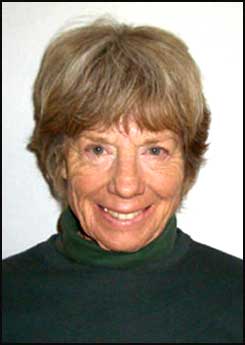
Doris Rusch 1942. WWII. I was born in Pine Bluff, Arkansas where dad, a post-doc Civil Engineer working for the war effort, enlisted in the Navy. Until the end of the war, dad was stationed at the Banana River Naval Air Base in Florida, the location of Cape Canaveral today. My recollections of life on the beach in what was locally known as the 'tip-top' house, (a ramshackle old place where it was unsafe to be upstairs) are of sand and surf and waving at seaplanes hoping dad would see us kids as he navigated those big low-flying planes, searching for German submarines.
After the war, we went west. Dad and mom were descendents of pioneers, and home was Utah. Dad soon became Dean of Engineering at Utah State, and built the Engineering building and Water Lab now named for him. He later became Vice President of Research at USU and also headed up the Soil and Water Section of The Agency for International Development, spending time in Washington D.C. and in many undeveloped countries.
I was finishing my BS Degree in Biology & Geology at Utah State University when I met my husband-to-be. At that time, in the very Mormon town of Logan, Utah, I was an old maid at 22, the last of my old classmates to still be single. I found Don, actually he found me, when was lost on the vast salt flats of the Great Salt Lake while hunting geese.
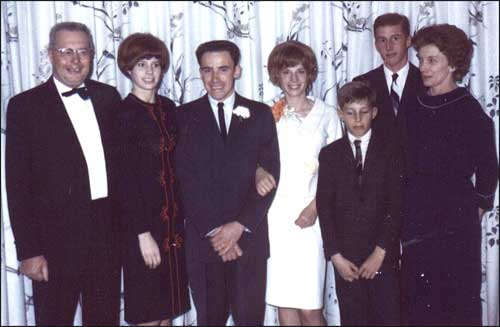
Married at home with my parents and siblings.
1985
A year later, we married and the following spring, got our degrees from USU. We both got accepted to UW Madison; Don for his PhD in Wildlife Ecology, me for an MS in Zoology & Ecology to begin in the fall. Though neither of us had any money, Don had a 1950 Ford pick-up and we decided to spend the summer driving to Alaska, living off the land and water. We made it to northern British Columbia and Alberta, eating fish and pancakes every day, before hightailing it to Madison to take up our graduate classwork. Good thing I was a lucky angler (Don was skilled, but I was lucky!)
After an initial graduate project working with desert fauna in Nevada, I got a grant and stipend from NIH to work in northern Alberta. The cyclical nature of populations of grouse/hares/lynx and other boreal animals had caught the attention of biologists. Studies to understand the causes of the '10-year-cycle' were fairly well funded. Don also was doing research there, and we had an exciting 3 years of chasing critters around the boreal forest. Hawks and owls were part of the study, since they constituted major grouse and hare predators, and we raised several immature raptors deserted by their parents.
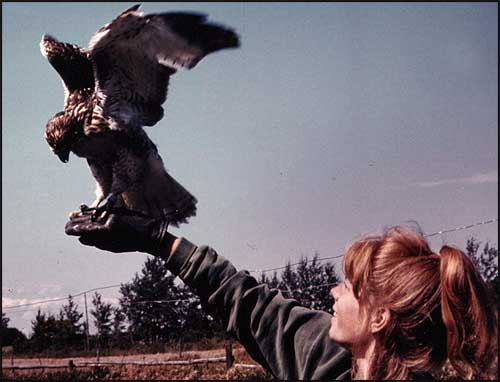
Fledging a young red-tailed hawk in Alberta boreal forest.
Returning to UW with all our research data and a couple of beloved mutts, we got our degrees, ready to enter the working world, just when there was little market for biologists. While we waited for replies to our resumes, we worked 7 days a week at the Wisconsin Cheese Factory. By then, we had a daughter, Jennifer. There were some dismal days before Don got a job offer from Manitoba Department of Resources and back north we went.
We had some awesome experiences in Manitoba, Don researching many critters, and me with the Manitoba Museum as a Field Naturalist. But soon it was back to UW Madison, where Don was offered the Leadership of the Fish & Wildlife Co-op Unit in the Department of Wildlife Ecology.
I eventually made my way into the Wildlife Bureau of the WDNR, first as an LTE, and then as a Program Planner, working mostly on statewide wildlife budgets and wildlife surveys. At that time I was pretty much the information specialist in the Bureau, having had one computer class. I did the analyses and reports of deer harvest, crowing counts, roadside surveys, and all other wildlife data and surveys. Working under John Keener and with the Wildlife Staff, I learned a lot, about a lot of things (including Wisconsin wildlife!). I also learned many new words and phrases. Chuck Pils was the Fur-Bearer Specialist, Ed Frank the Upland Game Biologist, Dave Gjestson, the Rules Analyst, and Harry Libby, the Wildlife Planner.
In those days, John Keener ran a tight ship and hunters were pretty much the only clients we served. "Leaving the Bureau" Party. Bureau Staff gave me my first Brittany, Tessie. What a fine Brittany she was. (Harry Libby, John Keener, Frank Haberlain also show in photo.) 1985
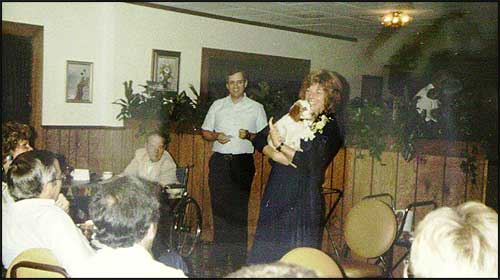
"Leaving the Bureau" Party.
Bureau Staff gave me my first Brittany, Tessie.
What a fine Brittany she was.
(Harry Libby, John Keener, Frank Haberlain also show in photo.)
1985
In 1985 I had an opportunity to move to the field as Madison Area Wildlife Supervisor, under Carl Batha, then the Southern District Wildlife Supervisor. I was nervous about the move since the wildlife field was dominated by males. In fact, Cindy Swanberg, a recent hire, and I represented the total female component of the Wildlife Bureau. But, Carl was supportive of my coming to the field, and I wanted so badly to go, it was a no-brainer. I never had a moment's regret. The field folk were the greatest, and I felt accepted immediately. I often think of those days as the best in my life. I lived and breathed the job. We bought, leased and managed lands for wildlife; planting, burning, share-cropping. We restored wild turkeys. We surveyed every kind of critter. We stocked pheasants and registered deer. Money was not too tight and most of our projects were funded. My team was a go-getter with a high level of energy and an abundance of knowledge.
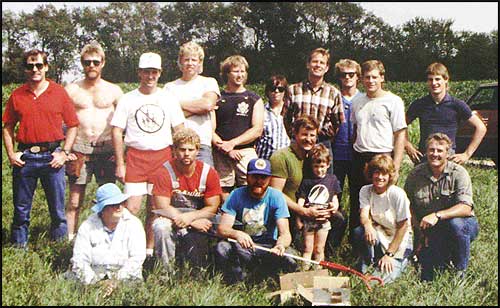
The entire Madison Area Wildlife team.
(including some interns and LTEs):
Doug Fendry, Al O'Leary, Mike Soergal, Dennis Gengler, Al Ramminger, Susan Bergquist, Brian Buenzow, Bruce Folley, Doris and Carl Batha
circa 1989
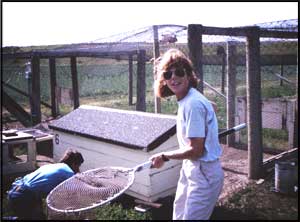
Chasing escaped pheasants
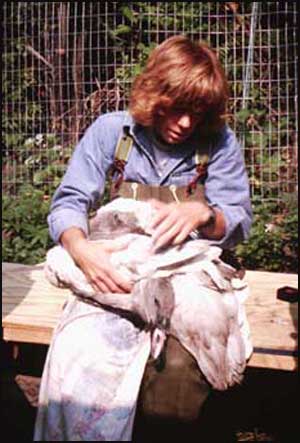
Raising trumpeter swans
After the reorganization in the mid-nineties, the Area Supervisor jobs were gone. I won a demotion (it was hard-fought) to be the Southern Wisconsin Natural Areas Field Biologist with the Bureau of Endangered Resource. This was a new adventure, with new lands to inspect and manage. I got up close and personal with many of the most pristine areas in southern Wisconsin, and played a part in keeping them pristine. I got to work with such greats as Mark Martin and Randy Hoffman. Money was much tighter, so we managed on a shoestring, but it was rewarding work and I was always tired by nightfall.
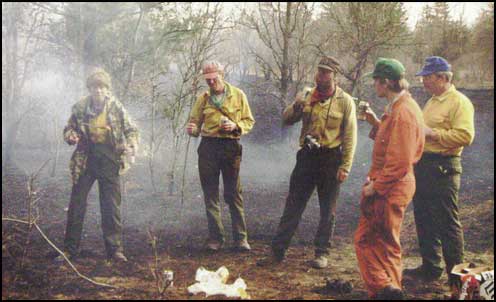
A moment of relaxation before mopping up a hot, hot burn at Mazomanie.
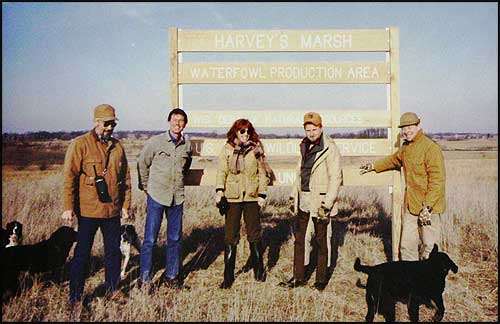
Spring pheasant survey with Gary, Dumper, Jim March and Jim Huntoon.
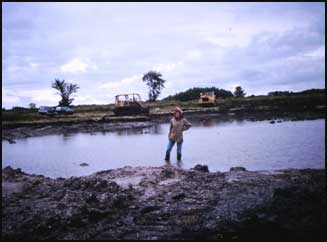
Plugging ditches, breaking tile at the Brooklyn Wildlife Area.
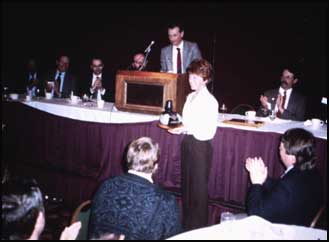
Receiving the 'Top Flight'
Award from Duck's Unlimited
Over these years, Don was working with many graduate students, doing research all over the North and South American continents, from Condors in Chile to Geese on Hudson Bay. We did a number of cooperative projects, including research on hunting rates for stocked pheasants (Don provided the funding), trying to restore ruffed grouse at Hook Lake (Don got the birds), and starting a hunter-education class for Wildlife Ecology Students, which has now grown to a nation-wide program. Jenny grew up, went away to college, became a star scholar, returned to Madison and entered the working world. She remains one of my best friends and confidants, and after 43 years, she may have found the 'perfect' guy (is there such a thing?). At long last, I might have a son-in-law soon. The bad news is that folks tell me the mother-of-the-bride must wear a dress during the ceremony. Yikes
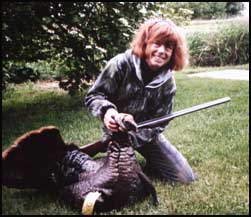
I released this adult male in 1987 at Hook Lake Wildlife Area. In 1993, I shot it the last day of the 5th period of the 2nd year the zone had been opened. The gobbler was 7+ years old.
Daughter Jennifer on a deer hunt.
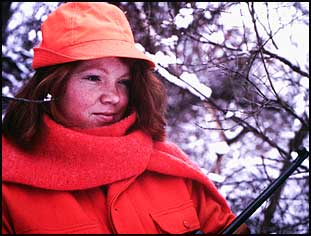
We also enjoyed many global trips to conferences or research areas, including South America, New Zealand, and Africa. It's hard to decide on the best adventure: banding waterfowl at a remote camp on Hudson Bay, jungle birds in the deep reaches of the Amazon, blue-winged teal deep within the Sienega of Columbia. We've had close calls with polar bears, piranhas, black mambas and Cartagena drug cartels. I've birded, hunted and fished in New Zealand, the cloud forests of the Andes Mountains, the Okavango Delta, Namibia and South Africa. I've fished in Costa Rica, dived in Honduras and Ecuador, and sailed the Galapagos Islands. I've traveled with my parents around India, where dad was working with villages to improve water storage, delivery and distribution. I've been mugged in Rome and I've flown over the Amazon jungle with armed monkey smugglers. In 1999, Don began talking about retiring in a couple of years, and we decided it would be a good thing for me to retire and travel with him as he meant to spend the last two years visiting various research areas. It was such a good plan. I retired in August, 1999. We began our first trip in September. The venture was to his Manitoba grouse research area and included the Prairie Grouse Conference. We took the dogs and stopped along the way to hunt sharp-tails in North Dakota. We hunted hard the first day and the next day Don died. As folks said, he died doing what he liked most to do, with his best companions by his side. But, still, it didn't seem fair.
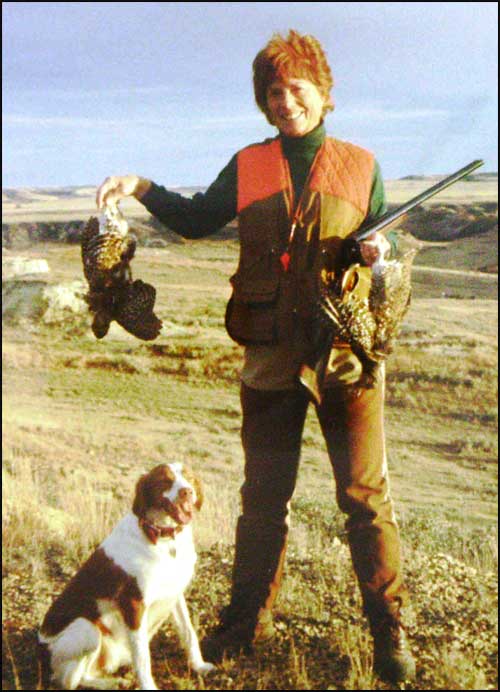
An annual North Dakota Teddy Roosevelt Grasslands sharp-tailed grouse hunt with Eliza.
The past decade or so, (since 2001), I worked for Dane County, helping spend the conservation fund to buy land, and grant monies to improve the habitat on those lands. I have also found a fine companion.
Bill is a retired radio news anchor, rodeo star, emergency responder and deputy sheriff who likes to hunt birds and bison. We've sailed the Bahamas, trekked Ecuador forests, snorkeled St. John's Island, rafted the 40-mile in Alaska, and sallied forth on many hunting trips closer to home with our Brittany spaniels, Eliza and Orion.
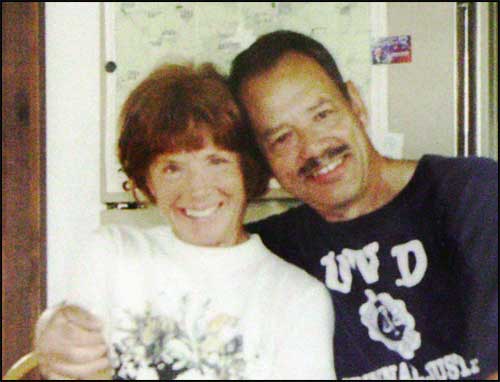
Bill and me . . . together for a decade!
After the war, we went west. Dad and mom were descendents of pioneers, and home was Utah. Dad soon became Dean of Engineering at Utah State, and built the Engineering building and Water Lab now named for him. He later became Vice President of Research at USU and also headed up the Soil and Water Section of The Agency for International Development, spending time in Washington D.C. and in many undeveloped countries.
I was finishing my BS Degree in Biology & Geology at Utah State University when I met my husband-to-be. At that time, in the very Mormon town of Logan, Utah, I was an old maid at 22, the last of my old classmates to still be single. I found Don, actually he found me, when was lost on the vast salt flats of the Great Salt Lake while hunting geese.

1985
After an initial graduate project working with desert fauna in Nevada, I got a grant and stipend from NIH to work in northern Alberta. The cyclical nature of populations of grouse/hares/lynx and other boreal animals had caught the attention of biologists. Studies to understand the causes of the '10-year-cycle' were fairly well funded. Don also was doing research there, and we had an exciting 3 years of chasing critters around the boreal forest. Hawks and owls were part of the study, since they constituted major grouse and hare predators, and we raised several immature raptors deserted by their parents.

We had some awesome experiences in Manitoba, Don researching many critters, and me with the Manitoba Museum as a Field Naturalist. But soon it was back to UW Madison, where Don was offered the Leadership of the Fish & Wildlife Co-op Unit in the Department of Wildlife Ecology.
I eventually made my way into the Wildlife Bureau of the WDNR, first as an LTE, and then as a Program Planner, working mostly on statewide wildlife budgets and wildlife surveys. At that time I was pretty much the information specialist in the Bureau, having had one computer class. I did the analyses and reports of deer harvest, crowing counts, roadside surveys, and all other wildlife data and surveys. Working under John Keener and with the Wildlife Staff, I learned a lot, about a lot of things (including Wisconsin wildlife!). I also learned many new words and phrases. Chuck Pils was the Fur-Bearer Specialist, Ed Frank the Upland Game Biologist, Dave Gjestson, the Rules Analyst, and Harry Libby, the Wildlife Planner.
In those days, John Keener ran a tight ship and hunters were pretty much the only clients we served. "Leaving the Bureau" Party. Bureau Staff gave me my first Brittany, Tessie. What a fine Brittany she was. (Harry Libby, John Keener, Frank Haberlain also show in photo.) 1985

Bureau Staff gave me my first Brittany, Tessie.
What a fine Brittany she was.
(Harry Libby, John Keener, Frank Haberlain also show in photo.)
1985
In 1985 I had an opportunity to move to the field as Madison Area Wildlife Supervisor, under Carl Batha, then the Southern District Wildlife Supervisor. I was nervous about the move since the wildlife field was dominated by males. In fact, Cindy Swanberg, a recent hire, and I represented the total female component of the Wildlife Bureau. But, Carl was supportive of my coming to the field, and I wanted so badly to go, it was a no-brainer. I never had a moment's regret. The field folk were the greatest, and I felt accepted immediately. I often think of those days as the best in my life. I lived and breathed the job. We bought, leased and managed lands for wildlife; planting, burning, share-cropping. We restored wild turkeys. We surveyed every kind of critter. We stocked pheasants and registered deer. Money was not too tight and most of our projects were funded. My team was a go-getter with a high level of energy and an abundance of knowledge.

(including some interns and LTEs):
Doug Fendry, Al O'Leary, Mike Soergal, Dennis Gengler, Al Ramminger, Susan Bergquist, Brian Buenzow, Bruce Folley, Doris and Carl Batha
circa 1989






Award from Duck's Unlimited
Over these years, Don was working with many graduate students, doing research all over the North and South American continents, from Condors in Chile to Geese on Hudson Bay. We did a number of cooperative projects, including research on hunting rates for stocked pheasants (Don provided the funding), trying to restore ruffed grouse at Hook Lake (Don got the birds), and starting a hunter-education class for Wildlife Ecology Students, which has now grown to a nation-wide program. Jenny grew up, went away to college, became a star scholar, returned to Madison and entered the working world. She remains one of my best friends and confidants, and after 43 years, she may have found the 'perfect' guy (is there such a thing?). At long last, I might have a son-in-law soon. The bad news is that folks tell me the mother-of-the-bride must wear a dress during the ceremony. Yikes

I released this adult male in 1987 at Hook Lake Wildlife Area. In 1993, I shot it the last day of the 5th period of the 2nd year the zone had been opened. The gobbler was 7+ years old.
Daughter Jennifer on a deer hunt.

We also enjoyed many global trips to conferences or research areas, including South America, New Zealand, and Africa. It's hard to decide on the best adventure: banding waterfowl at a remote camp on Hudson Bay, jungle birds in the deep reaches of the Amazon, blue-winged teal deep within the Sienega of Columbia. We've had close calls with polar bears, piranhas, black mambas and Cartagena drug cartels. I've birded, hunted and fished in New Zealand, the cloud forests of the Andes Mountains, the Okavango Delta, Namibia and South Africa. I've fished in Costa Rica, dived in Honduras and Ecuador, and sailed the Galapagos Islands. I've traveled with my parents around India, where dad was working with villages to improve water storage, delivery and distribution. I've been mugged in Rome and I've flown over the Amazon jungle with armed monkey smugglers. In 1999, Don began talking about retiring in a couple of years, and we decided it would be a good thing for me to retire and travel with him as he meant to spend the last two years visiting various research areas. It was such a good plan. I retired in August, 1999. We began our first trip in September. The venture was to his Manitoba grouse research area and included the Prairie Grouse Conference. We took the dogs and stopped along the way to hunt sharp-tails in North Dakota. We hunted hard the first day and the next day Don died. As folks said, he died doing what he liked most to do, with his best companions by his side. But, still, it didn't seem fair.

The past decade or so, (since 2001), I worked for Dane County, helping spend the conservation fund to buy land, and grant monies to improve the habitat on those lands. I have also found a fine companion.
Bill is a retired radio news anchor, rodeo star, emergency responder and deputy sheriff who likes to hunt birds and bison. We've sailed the Bahamas, trekked Ecuador forests, snorkeled St. John's Island, rafted the 40-mile in Alaska, and sallied forth on many hunting trips closer to home with our Brittany spaniels, Eliza and Orion.
